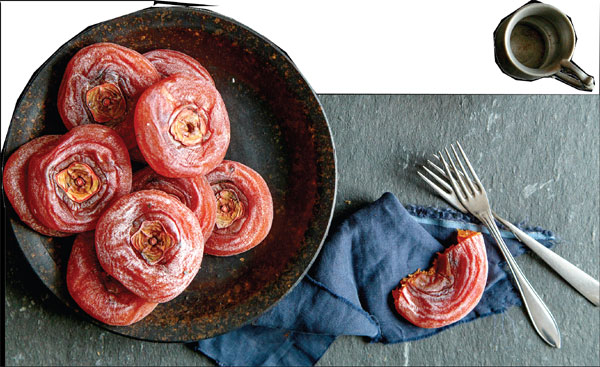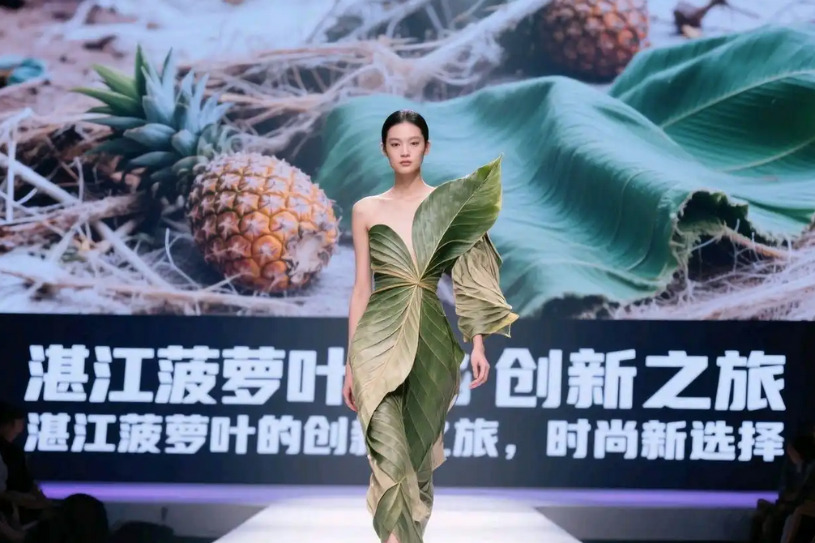Persimmons: gift of the gods

Editor's Note: China is divided into as many culinary regions as there are different ethnic groups. Its geographical diversity and kaleidoscopic cultural profiles contribute to the unending banquet of flavors.
When we were still living in the staff quarters of the People's Daily campus in Beijing, there would be occasions when we had to venture into the main buildings to pay our utility and internet bills.
The access by the western gate nearest us was through a long driveway lined with persimmon trees.
| Dried persimmons. Photos Provided to China Daily |
In winter, it was a really pretty sight, for the persimmons would still be hanging high on the trees, each a bright orange globe topped by a cap of snow. They were like a parade of festive lanterns.
Those were the days before the trees, and driveway, were bulldozed to make way for the current glass and concrete tower that has become the paper's proud landmark north of the Third Ring Road.
Persimmons, or Diospyros kaki, are native to Asia and widely cultivated in China, the Korean Peninsula and in Japan. There are two main varieties, roughly divided by their astringent and non-astringent fruit
In the north, the large squat round fruit with a belly fold around its middle is most common. This is the astringent variety and it must be thoroughly ripened before it can be eaten. Country folks have various ways to hasten the process.
The tannin in the fruit is what makes your mouth pucker when you bite into a persimmon that's not quite ready for eating. Sometimes, the tannin is so strong it will leave a layer of white residue in the mouth. Ask any impatient child in Beijing.
In the old hutong, persimmons were cheap treats in late fall to winter. They were laid outside on window sills and roof ledges to freeze as temperatures dropped.
When it was time to eat, the fruit were taken indoors while eager mouths gathered and waited. The whole frozen persimmon would be submerged in a bowl of cold water as it thawed, and when a crust of ice floated on the water, it was ready to eat.
Every child would be handed a persimmon and a spoon, and it was like eating a half-frozen fruit sorbet. My husband said it was a rare and treasured childhood treat. His favorite was the chewy slightly crisp internal membrane that surrounded each of the jet-black seeds, the "tongues" inside the fruit.
For me, growing up in Singapore, my first memory of a persimmon was the dried fruit, a moist, dark brown titbit covered in a layer of frosty white. My grandmother called them shibing, or persimmon cookies, and she would soak them in hot water first before doling them out.
They were delicious, of course, but so very different from the fresh fruit that I didn't recognize them as being the same until I was a lot older.
Part of the reason a lot of Chinese persimmons used to be dried and preserved as shibing is because it is such a fiddly fruit.

When it is fully tree-ripened, it does not travel well at all and will bruise very easily. Most fresh persimmons are sold when they are still hard and full of tannin. When they are brought home, they must be set aside in a covered container with a banana, or more often than not, with an apple, the other fruit of autumn.
The ethylene gas released by the apple or banana is what will soften the fruit and make it edible. The old Beiijng way is to put them outside in the freezing cold so the frost breaks down the fruit tissues.
The other variety common in China is the smaller, heart-shaped persimmon called hachiya. They ripen while still hard and crisp, and then soften to the familiar squishiness.
Persimmons are now cultivated all over the world in California, New Zealand, Australia, Spain and the Mediterranean, and, of course, in Israel, where they are marketed as Sharon fruit.
But nowhere are they so much a part of autumn and winter as they are in China, where the fruit stay on the trees well into the season, freezing on the branches and adding little spots of bright orange to the cold grey winter landscape.
Chinese farmers take a lot of trouble drying the fruit. Ripe fruit are slowly sun-dried until most of the moisture evaporates. Persimmons are rich in fructose and glucose, and these sugars rise to the surface of the skin, forming the characteristic powdery white crust.
Dried persimmons are excellent dry rations because of their high sugar content and nutrition. They are also highly popular in desserts such as sweet soups, cakes and cookies.
These days, creative Chinese chefs are starting to use both fresh and dried persimmons in their dishes.
There are few fruits native to northern China that grow so abundantly and are so affordable. It is little wonder, then, that this sweet, luscious fruit is often called the gods' gift to the common man.
Persimmons are wintertime delight
Dried persimmon fruit cake
150g butter
150g caster sugar
150g plain flour plus 1 teaspoon baking powder
1 teaspoon ground ginger
4 eggs
3 whole dried persimmons
1 cup shelled walnuts, roughly chopped
Remove calyxes from the dried persimmons, rinse and cut into little cubes. Toss with a tablespoon of flour and set aside.
Cream butter and sugar together till light and fluffy. Add in the eggs and whisk well.
Sieve flour, ground ginger and baking powder and add to the butter mixture. Cut and fold to incorporate the flour.
Finally fold in the persimmon cubes and walnuts. Bake at 180 C for 40 to 45 minutes. Test with a skewer. When it comes out clean, your cake is done. You can also bake the batter in muffin tins for fruity cupcakes.
Beijing frozen persimmons
Beijing persimmons are squat and fat, and they have a fold in the middle like a generous beer belly.
They are most commonly eaten with spoons. The ripe fruit is often frozen so it can be enjoyed throughout the winter.
When it's time to eat, the frozen fruit is placed in a bowl of cold water to thaw. Then it is eaten with a teaspoon, scooping out the semi-frozen flesh, with the persimmon skin acting as a fragile container.
(China Daily Africa Weekly 11/10/2017 page18)
Today's Top News
- Xi, Myanmar leader exchange congratulations on 75th anniversary of diplomatic ties
- Hong Kong's new vitality a rebuttal to naysayers
- He Lifeng to visit the UK, hold first meeting of China-US economic, trade consultation mechanism
- Ecosystem of humans and machines key to ensuring cybersecurity
- China, Canada vow to deepen bilateral bond
- Keep two-state solution alive, says UN chief































